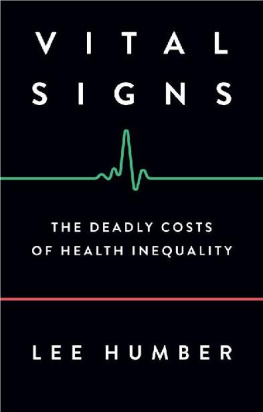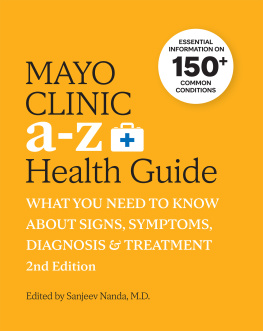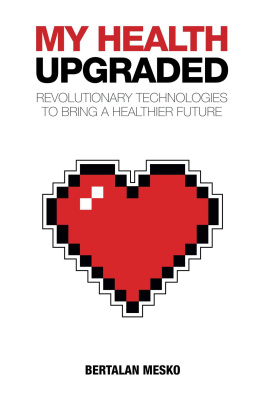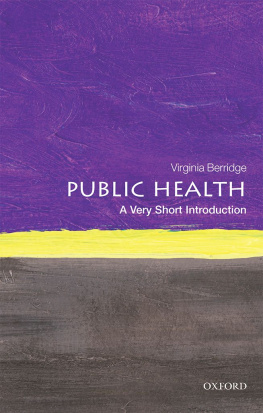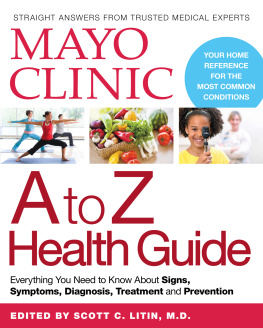Vital Signs
Vital Signs
The Deadly Costs of Health Inequality
Lee Humber

First published 2019 by Pluto Press
345 Archway Road, London N6 5AA
www.plutobooks.com
Copyright Lee Humber 2019
The right of Lee Humber to be identified as the author of this work has been asserted by him in accordance with the Copyright, Designs and Patents Act 1988.
British Library Cataloguing in Publication Data
A catalogue record for this book is available from the British Library
ISBN 978 0 7453 3834 7 Hardback
ISBN 978 0 7453 3832 3 Paperback
ISBN 978 1 7868 0424 2 PDF eBook
ISBN 978 1 7868 0426 6 Kindle eBook
ISBN 978 1 7868 0425 9 EPUB eBook
This book is printed on paper suitable for recycling and made from fully managed and sustained forest sources. Logging, pulping and manufacturing processes are expected to conform to the environmental standards of the country of origin.
Simultaneously printed in the United Kingdom and United States of America
Typeset by Stanford DTP Services, Northampton, England
Contents
List of Figures
1
Introduction
This is a book about health. It is an analysis of what health is and what it isnt. It offers an understanding of the nature of health inequality and why it exists. Centrally, Vital Signs contends that health is a complex phenomenon rooted in the conditions in which we live and in history. In order, therefore, to understand and address the unequal distribution of good health and long lives which characterises the twenty-first century, we need to know about and get to grips with the significance of the periods in history when health has improved. In Vital Signs I ask: what is at the core of health inequality and what does history tell us we can do about it?
Vital Signs joins a growing body of work casting a critical eye on the sorts of societies that have produced the current deepening health problems. When she retired in 2017, then director general of the World Health Organisation, Dr Margaret Chan Fung Fu-chun, said: The challenges facing health in the 21st century are unprecedented in their complexity and universal in their impact. Under the pressures of demographic ageing, rapid urbanization, and the globalized marketing of unhealthy products, chronic non-communicable diseases have overtaken infectious diseases as the leading killers worldwide.
Between them Chan, Birn and Pillay clearly illustrate where the health debate and global health agenda needs to focus in the twenty-first century. In rapid urbanisation Chan references not only the global spread of cities but the poor and often squalid living conditions that exist within them, affecting populations across not only the low- and middle-income countries (LMICs), but also areas and whole regions of the higher income countries (HICs), including swathes of the European Union, the US, China and Australasia. This is not simply a set of economic, social and political inequalities that exist between countries, these same inequalities in health exist within countries and within cities themselves as the work of authors such as Danny Dorling, Kate Pickett and others continues to expose. In the highly skewed distribution of wealth, Birn and Pillay point to the inequity and inequality that has become central to the critical analysis of global health over the last decades with a general acceptance among academics that health inequalities are linked to wealth inequality and represent a clear and present danger to the continuance of democratic societies as we have known them since the end of World War II. This same and ever-widening experience of inequality shapes the nature of disability, illness and disease such that by less than two decades into the new millennium non-communicable disease by which Dr Chan means disease governed by the social and political environments in which we live is the main source of premature death, shorter life expectancy and lives lived with disability. Today, the societies and environments weve built are humankinds main life-threatening enemies. To try and understand the nature of this problem and to suggest possible solutions, Vital Signs provides an analytical framework, based on a critical reading of health-related history and ideas. Before I do that, however, it is important to establish some broad definitions of some of the major themes, terms and institutions which will inform this critical analysis. Throughout, I refer both to broad concepts of health and to healthcare. By healthcare I mean the organisation and provision of medical and social care to individuals or communities. On rare occasions in the book I focus solely on social care in order to develop analysis. The rest of the time I include health services and social care services in the term healthcare.
What do we understand by the term health? Despite the fact that in many senses a biomedical understanding of health has dominated the topic, with its view of health as largely the relationship between human biology and the natural world, there is no consensus on the definitions of what health actually is, even though the concept is central not only in medicine but also in the health social sciences (e.g. medical sociology, health psychology and medical demography). This may seem strange, Even here we see health as coterminous with what it enables us to do, and the roles it enables us to perform. Health, then, is pre-eminently a social phenomenon.
In 1948, in a radical departure from previous definitions and with the establishment of the World Health Organisation (WHO), a new definition linking health to a continual process of well-being was proposed. This definition understands health as resulting from changing relationships between physical, mental, and social well-being, and not merely the absence of disease and infirmity. The medical establishment, with its traditional and narrower focus on the bodys relationship with disease only, remain suspicious of attempts to develop new definitions. For years following 1948, WHOs proposals were set aside as an impractical ideal.
New approaches to health began to gain purchase as late as the 1980s, with keynote documents like the Ottawa Charter of 1986 beginning to affect public and professional opinion. Following Ottawa, health began to be seen as a resource for living, a much more positive approach than previous absence of disease interpretations. For many, health began to be understood in a much more holistic way as the extent to which an individual or group is able to realize aspirations and satisfy needs and to change or cope with the environment. Health is a resource for everyday life, not the objective of living; it is a positive concept, emphasizing social and personal resources, as well as physical capacities.focusing in on the individuals or groups ability to cope with the environment this definition highlights the impact upon us of the world in which we live. This was a clear move away from biomedical concepts of health based on individualised struggles between individual bodies and disease. Instead, health can be understood as a relational process between humans and their societies. This definition opens the door to an approach which sees health as socially determined. In order to ensure the best of health, we need to ensure the best of societies that are most supportive of the health of all. Following Ottawa, health begins to reveal itself in its true form, as an ongoing collective and political struggle against those aspects of society that threaten and undermine it.
A specifically social model of health was developed to its clearest formulation early on by the sociologist Talcott Parsons (190279). He defines health as the state of optimum capacity of an individual for the effective performance of the roles and tasks for which he has been socialized.

